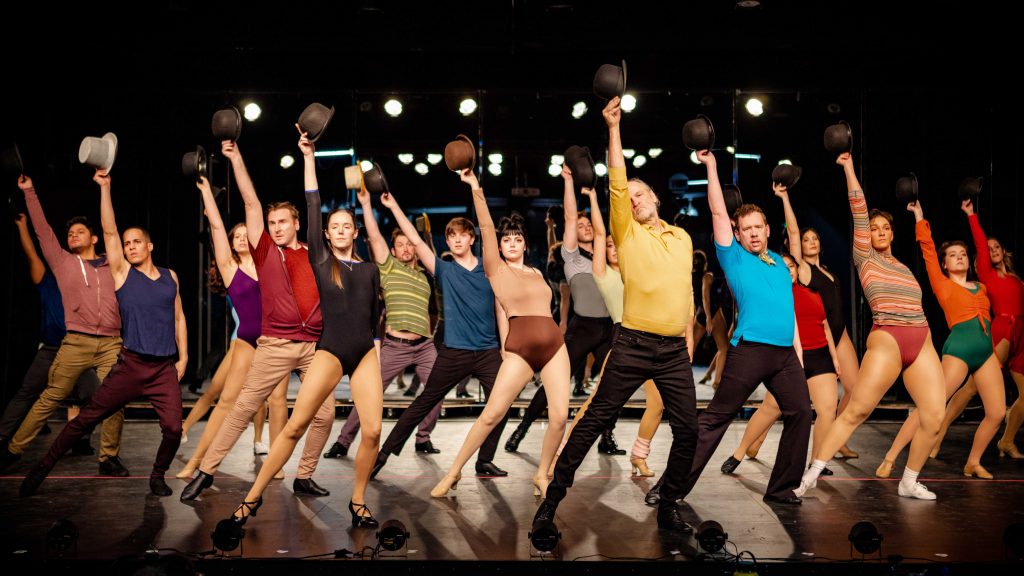In the early 1970s, Tony Award winners for best musical included Applause, based on All About Eve; Company and A Little Night Music by Sondheim; Two Gentlemen of Verona; Raisin (as in “in the Sun”) and The Wiz. In 1977 the winner was Annie. Worthy shows all, to be sure, but none landed with the impact of A Chorus Line in 1975. It didn’t just win best musical, it won pretty much everything there was to win: best book, score, leading actress, featured actor and actress, direction, choreography (Bob Avian and director Michael Bennett), costumes, lighting. Throw in eight Drama Desk awards, a special Theatre World Award and a Pulitzer Prize. Not only was it a critical darling, it ran for 6,137 performances, the most till Cats finally surpassed it in 1997. So why don’t community theaters produce it more often? The answer’s simple: It’s bloody hard to get right.
There are 26 people in the cast, and each needs to be a true triple threat; yet somehow director and choreographer Eric Clausell managed to get this show beautifully right at Tacoma Little Theatre (TLT). That was March of 2020. We know what happened next. It played for three performances before the COVID-19 pandemic forced it on ice.

We spoke to Clausell after A Chorus Line‘s reopening-night performance on Friday. “It was heartbreaking,” he said of the forced interruption, “because we had a similar reaction to the show like we’re having tonight. We were all so pumped and so excited, and we felt that the COVID cloud was coming. We all felt it, but we just hoped beyond hope that we would somehow skate through. And we held on, literally, till hours before to see if we could do it a second weekend, but the mandates came down and we had to shut it down.” The company rehearsed for six weeks before its first opening night in 2020. About 60 percent of the cast was able to come back for six additional weeks of rehearsal to restore it for a masked but riveted audience.

The show starts before the curtain rises, thanks to a mid-’70s Manhattan soundscape and George Benson’s version of “On Broadway.” The stage is bare, with what turn out to be seven periaktoi, rotating triangular prisms, comprising the upstage wall. This space will soon be filled with beautiful bodies in motion. The characters are dancers at a Broadway audition, desperate for paying jobs and a chance to strut their stuff on the Great White Way. Their showbiz dreams haven’t thus far amounted to much, but director Zach, a taskmaster with what may or may not be a heart of gold, represents a slim window of hope. As he interrogates the auditioners, he discovers the struggles that underlie their ambitions. Some performers fled homophobic small towns. Others wrestle with the body shaming so pervasive in the entertainment business and society at large. Another must reluctantly pursue an unnamed chorus position despite having earned featured roles just a few years before. We meet dozens of dancers who sweat and strut in lockstep, but how many people does Zach need?
As we watched the show, my wife leaned over and asked, “Where did they find all these dancers?” Because make no mistake, these dancers are really, really good, and the choreography is unforgiving. “Now, this is important,” Zach announces. “I want to see unison dancing. Every head, arm, body angle, exactly the same. You must blend. This is one of those numbers where you back the star — You’re her frame. I don’t want anybody to pull my eye.” Then the cast has to power through the steps for the aptly named “One” for the next 20 minutes, each move identical to its neighbors, as dramatic confrontations and scene changes happen all around. Then the dancers change costumes in a matter of seconds and power through the steps all over again, athleticism at its finest and most demanding.

So exactly where did Clausell find all those dancers? “Well,” Clausell explained, “there’s a lot of great talent in the community, a lot of amazing women — not so much with men. So I had to teach them how to dance. I had to teach a lot of people how to dance. I’m a dance teacher.” Two years ago, the cast initially thought they might have to delay the remainder of their run for a couple of weeks, but that dream, like the dreams of these characters, kept receding into the distance. Yet TLT and its managing artistic director, Chris Serface, knew a good thing when they saw it, so this revival marks the official debut of a theater that’s been beautifully restored during its two-year downtime. If anything, it’s a far more comfortable environment in which to see “One” spectacular piece of entertainment.
“It’s surreal for everyone,” Clausell agreed about the COVID hiatus. “Two years of our lives have gone by, and so much has happened in two years. The only word to describe it is ‘surreal.’ “
Through the remainder of its Chorus Line run, in lockstep with numerous performing-arts organizations in Tacoma, TLT will require proof of either a negative COVID test result within the last 72 hours or a vaccination card with photo ID. Get the shot; make the drive. This show is truly one singular sensation.
Photo credits: Dennis K Photography and Tacoma Little Theatre.
WHAT
A Chorus Line
WHEN
7:30 p.m. Fridays and Saturdays;
2 p.m. Sundays through April 3;
pay-what-you-can performance 7:30 p.m. Thursday, March 24
WHERE
Tacoma Little Theatre,
210 N. I St., Tacoma
HOW MUCH
$22-$29
LEARN MORE
253-753-8586
tacomalittletheatre.com

